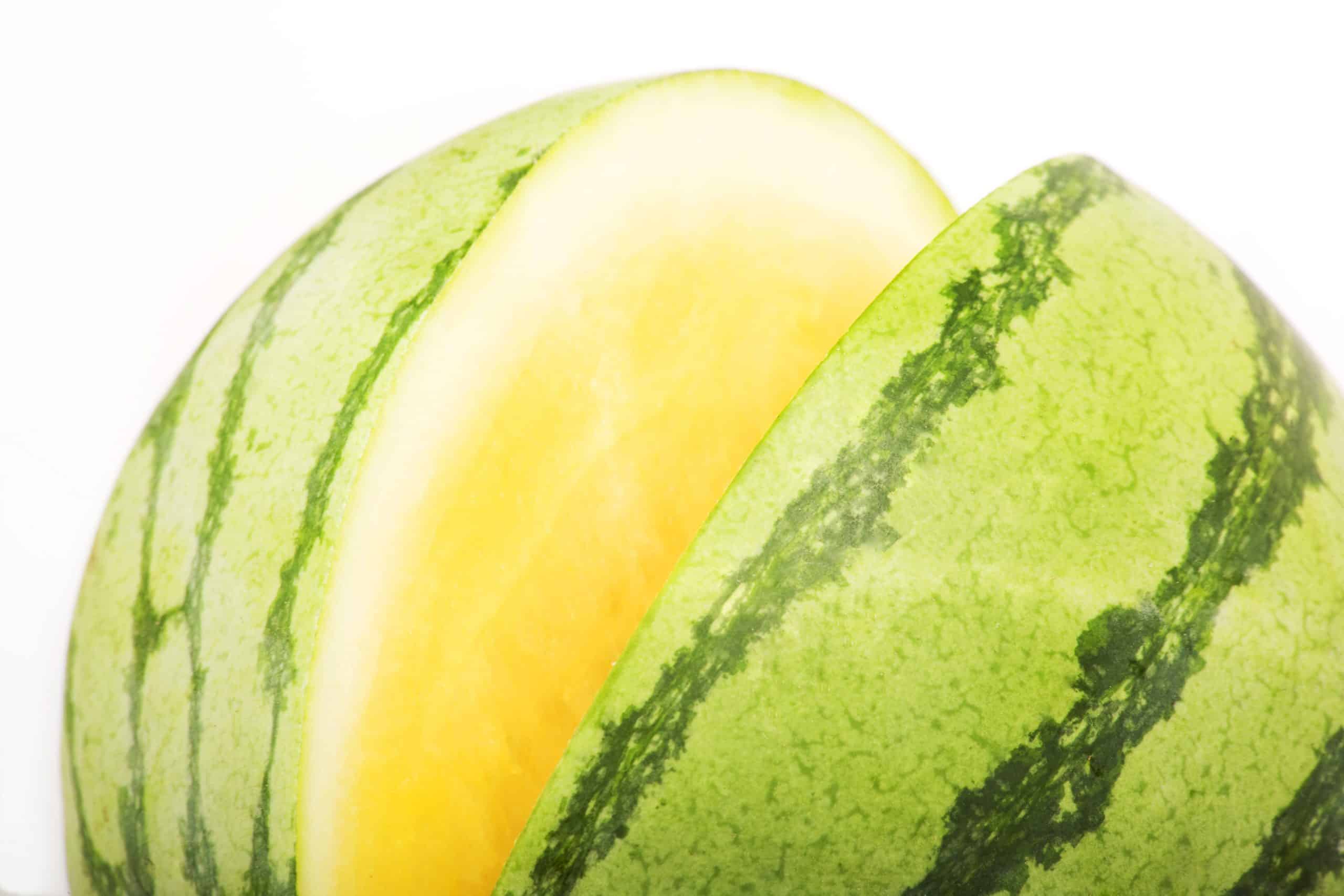If you haven’t tasted a yellow watermelon before, you’re in for a treat. They are sometimes sweeter than pink and red varieties.
I never heard of them until we grew them. It’s easy to grow yellow watermelons if you live in a warm climate. You’ll need to give them enough space because they are vining plants. I’ve had success growing them in large planters and in garden beds.
Learn about yellow watermelon varieties and what it takes to grow them from seed. They are low maintenance and beginner-friendly.
Yellow Watermelon
In the spring, we planted watermelon from the seed program at our library. However, we didn’t read up on the variety.
Little did we know we planted yellow-meated watermelon (Tohono O’odham yellow-meated). They melons grew. In the summer, we harvested them.
What a surprise to cut them open and see yellow watermelon! It was quite the sight!
We had a really hot summer and thought it was overripe. We thought we would be tossing them into our compost tumbler.
But when we ate some, it was fantastic. It was crispy, sweet and tasted like regular watermelon.
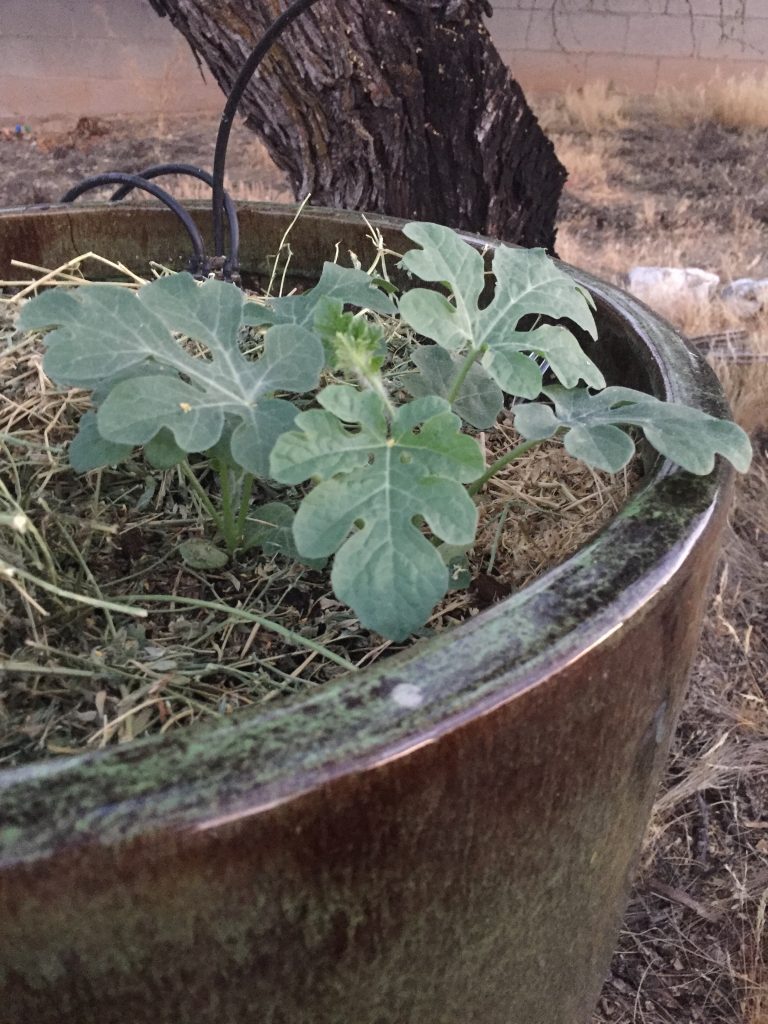
Growing Yellow Watermelon
Growing watermelon is pretty much the same, no matter what type you grow. Watermelons are annuals which means you need to plant them each year.
Yellow watermelons, like traditional pink watermelon, thrives in warm weather and direct sunlight.
Choose a smaller, fast-growing variety if you are new to growing watermelons. Some yellow watermelon varieties to consider planting are:
- Yellow Petite
- Yellow Doll
The scientific name for watermelon is Citrullus lanatus. A warm weather plant, it grows best in hardiness zones 3 – 12. Some varieties do better in certain zones.
Requirements to Watermelon Plants
- Full sun for a minimum of 6 hours each day
- Nutrient-rich soil
- Plant only one variety or type
- Enough space
- Warm temperatures; plant in the correct season
- Consistent watering until harvest time
Difference Between Red and Yellow Watermelon
In addition to the color difference, red fleshed watermelon contains lycopene, an antioxidant that makes fruits and vegetables red and pink.
Yellow lacks lycopene. The lycopene content is the big difference.
Yellow, red and pink watermelons are high in vitamin A and C. Other nutritional benefits and health benefits are similar.
In addition, both red and yellow melons have the same type of crisp texture, grow with rinds, and can grow with seeds or seedless.
How to Grow Yellow Watermelon
After the last frost, it’s time to plant watermelon seeds. You can plant them directly into the ground, in raised garden beds, or in pots. There is no need to transplant them.
Plant only one variety
While there are many varieties of watermelon, only plant one type.
Yes, it will be tempting to plant yellow watermelon along with red watermelon but don’t. Choose just one variety to avoid cross-pollination.
If you want to grow a second variety, you’ll need to ensure they are a minimum of a half an acre apart from each other.
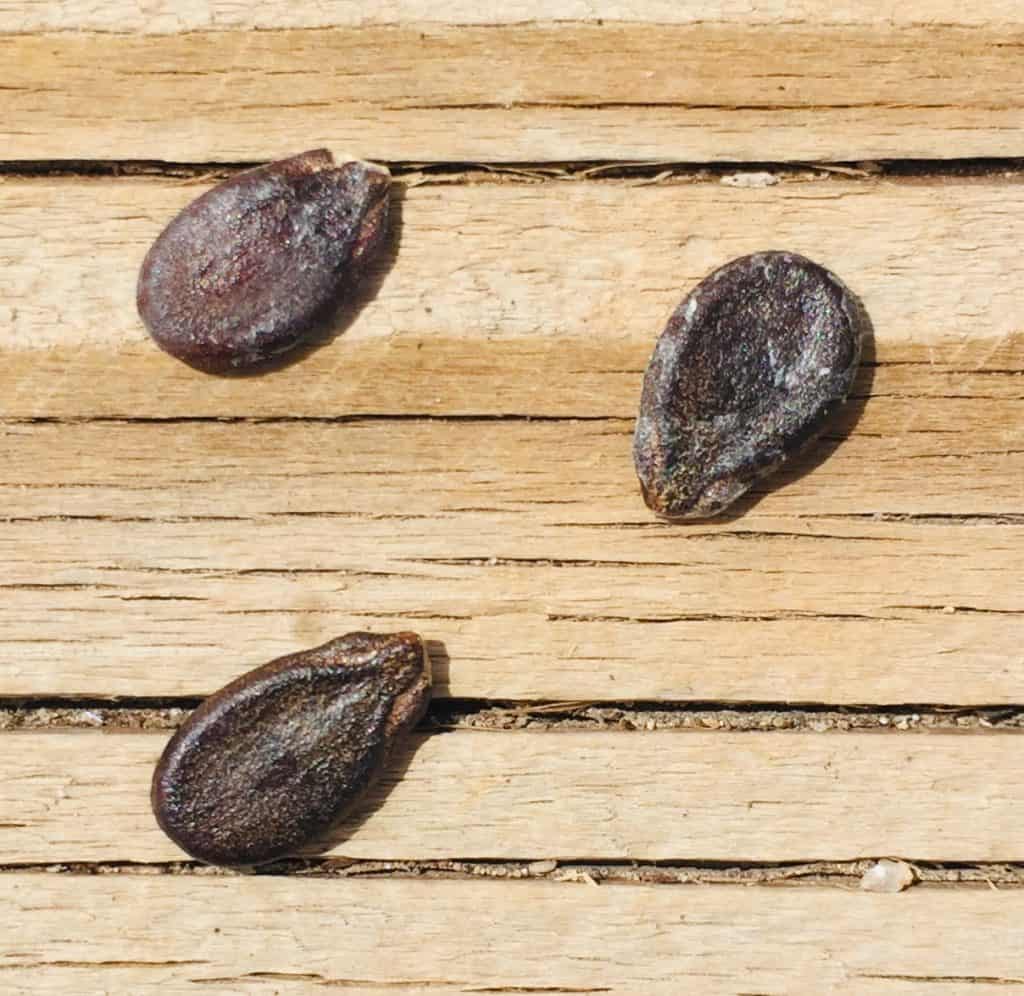
Soil
Watermelons require well-draining, nutrient-rich soil. Sandy and loamy soils work best. They prefer slightly acidic soil. The pH level should be between 6.5 – 7.
Sunlight
Like fruit-bearing plants, yellow watermelon requires a minimum of six hours of direct sunlight per day.
When to plant
In most growing zones, plant once soil temperatures reach 70 degrees F. This is after the last frost. Typically, this is spring in most areas. They’ll grow in time for a summer harvest.
Planting seeds
In a garden bed or in the ground:
- Plant 3 – 4 seeds per hole
- Sow seeds one inch deep
- Space seed groups 5 – 6 feet apart
If you are planting in a garden, plant them on hills or mounds. This will help the roots stay warm.
However, if you live in climate zone 9 – 13, do not hill the dirt. In hot climates, you’ll want to keep the roots cooler. Add mulch instead.
In a pot:
- Make sure the pot is at least 5 gallons
- It must have drainage holes
- Choose if you want to train yellow watermelon plants vertically or let them grow toward the ground. It will depend on how tall the pot is.
- Sow 4 seeds per container
- Plant them one inch deep
Planting starts
If you are planting an established yellow watermelon plant, give them space as you would seeds. Mound or hill the dirt, placing one plant every 60 – 72 inches.
If you live in a consistently hot climate (zones 9b and higher), avoid hilling the dirt. Use mulch to protect the roots.
After germination
Yellow watermelon seeds can take up to two weeks to germinate. During this time, water frequently.
Thin out the plants. Choose your strongest seedling per grouping and snip the rest at soil level with scissors. This way, you will nurture your strongest yellow watermelon seedlings.
Watering
- Consistent watering until fruit begins to develop
- Soil should be moist
- Once the melon grows, water 1 – 2 inches of water per week
- When the fruit reaches its full size, stop watering 7 – 10 days before harvest for the best flavor
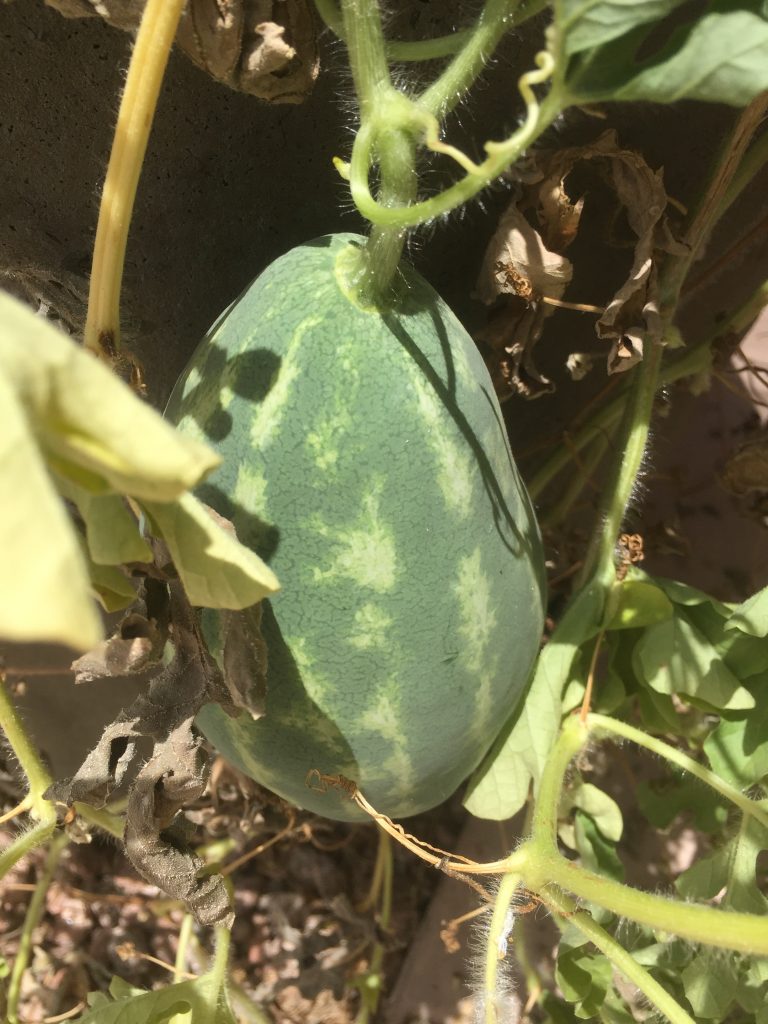
Fertilizer
When feeding plants, choose a fertilizer with a high nitrogen content. Stop once the flowers have formed.
After the plants flower, dress with a fertilizer higher in phosphorus and potassium.
Mulch
Keep the weeds at bay with mulch which will compete for nutrients. You can use grass clippings, leaves, straw, hay, alfalfa.
Mulching will help keep roots cool if you live in a hotter climate. It will help the plants retain moisture.
Pruning
You can snip dead vines and leaves; however, pruning isn’t necessary.
Wildlife and Insects
Just like with red melons, you’ll have to watch for pest with the yellow varieties. You can grow them in pots and planters closer to your home if you have a lot of wildlife.
In a garden bed, cover it at night. Still, you may have critters that eat the melons, especially if they are on the ground.
Diseases
Plant organic seeds when possible.
When watering yellow watermelon seeds and plants, look for signs of fungus and disease. Common ones are:
- Anthracnose
- Bacterial Fruit Blotch
- Cucumber Green Mottle Mosaic Virus
- Gummy Stem Blight
Harvesting
It’s important to learn how to tell if yellow watermelon is ripe before picking it.
- Know what types of yellow watermelon seeds you planted.
- Mark when you planted in a calendar or notebook.
- Note how many days it takes for the variety to be ready for harvest and mark it on the calendar.
Then, you can anticipate when it will be ready to harvest. Typically, the stem will turn brown and break away from the melon. The tendrils will be brown and not green.
The watermelon should have a dull appearance. It won’t be shiny.
The side resting on the ground should be yellow. Knock on the melon. It should sound hollow.
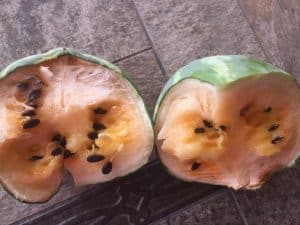
Hydroponics
You can grow yellow watermelon plants with hydroponics but it’s not recommended. This is because most varieties take up a lot of space.
Yellow Watermelon Varieties
There are many types of watermelon.
Rinds can be light yellow to rich gold tones. The fruits can be oblong or round. The melons can be seeded. There are also seedless varieties. Here are some popular ones to grow.
- Buttercup
- Also called Yellow Buttercup and Buttercup Yellow
- Considered one of the best tasting yellow watermelons
- Medium green rind
- Germinates in 4 – 14 days
- 90 days to maturity
- Grows 14 – 16 pounds
- Seedless
- Grow with sidekick pollinator plants
- Dense yellow flesh
- High sugar content
- Cream of Saskatchewan
- Round
- Pale yellow flesh, can be almost white
- Each vine produces 2 – 3 melons
- 80 – 85 days from when sprouts appear to mature fruit
- Desert King
- Light green pea color rind
- Oblong shape
- Yellow flesh
- More drought-resistant than other varieties
- Grows up to 15 – 20 pounds
- 85 days to maturity; can remain on vine longer
- Juicy and sweet
- Stores well
- Gold in Gold
- Yellow and gold melon rinds
- Yellow flesh
- 80 – 85 days to maturity
- 8 – 10 foot spread (area to grow)
- Grows 5 – 8 pounds
- Burpee exclusive hybrid
- Lemon Krush
- Hybrid variety
- 16 – 18 pounds
- Yellow-fleshed
- Mature in 85 days
- Mountain Sweet Yellow
- Heirloom variety
- Oblong
- Dark green rinds
- Dark yellow flesh
- 20 – 35 pounds
- Mature in 100 days
- Very high sugar content
- Red in Gold
- Yellow and gold rind
- Pink inside; this is the only one on our list that doesn’t have yellow meat; another variety is Golden Midget (yellow rind; red meat)
- 80 – 84 days to mature
- 8 – 10 feet spread
- 4 – 7 pounds when ripe
- Burpee hybrid
- Tastigold
- Yellow and gold rind
- Pink and red flesh is crisp
- 8 – 25 pounds when ripe
- Tohono O’odham Yellow-Meated
- Also called Gepi
- Yellow to orange flesh
- Grow to 35 pounds
- Tolerates hot weather
- Yellow Baby
- Thin rind
- Grows up to 9 pounds
- Few seeds
- Yellow Crimson
- Rind is medium green with light green and yellow stripes
- Early variety; ripe in 80 days
- Weigh up to 10 pounds
- Similar to Crimson Sweet (red variety)
- Open pollinated
- Climate zones 3 – 12
- Yellow Doll
- Extra early hybrid; matures early
- Round and oval shaped
- Medium green rinds
- 5 – 7 pounds at maturity
- May start indoors 2 – 3 weeks if live in cooler climate
- Germination: 4 – 14 days
- 68 days to mature
- Soil temp 75 – 80 degrees
- Sweet
- Yellow Flesh Black Diamond
- Long and oblong
- Thick rinds
- Mature weight is 30 – 50 pounds
- Yellow Petite
- 65 – 80 days for ripe watermelons
- Grows to 4 – 7 pounds
- Called icebox watermelon or personal watermelon
- Ideal for small gardens
- Ideal for shorter growing seasons
- 36 – 48 inches apart
- Plant seeds at one inch depth
- Hardiness zones 3 – 10 use
- High sugar content
Yellow watermelon uses
You can enjoy it just as you would traditional watermelons. Cut it up for a sweet treat, as a snack, and as part of a meal. You can cube it as part of a fruit salad, appetizer, and more.
FAQs
Here are some popular questions and answers about this unusually-colored fruit.
Is yellow watermelon safe to eat?
Yes, there are varieties that produce yellow flesh instead of red.
What’s the name of yellow watermelon?
There are several varieties, including Yellow Baby, Yellow Doll, Yellow Crimson, and many more.
Where do yellow watermelons grow?
Yellow watermelons grow much like red watermelons. Each variety will do better in a specific hardiness zone. For example, the Tohono O’odham is loves heat, and grows well in growing zone 9b.
Can you buy yellow watermelon?
You may see yellow watermelon occasionally in the grocery store. It will likely be in the refrigerated section pre-cut into chunks. You’ll be more apt to find it at more specialty grocery stores.
Buy yellow watermelon seeds to grow at home. Buy online from a reputable seed company. You can also check garden centers, home improvement stores, and nurseries.
Is yellow watermelon sour?
No, yellow watermelon fruit is not sour. In fact, many yellow watermelons have a higher sugar content than red ones. They taste sweet and have a firm texture like red melons.
How long has yellow watermelon been around?
Many believe it’s been around longer than red varieties and pink watermelons. Part of the Cucurbitaceae family, it was originally domesticated in Africa.
Are yellow watermelons rare?
While you won’t find them often in the grocery store, they aren’t rare or more difficult to grow.
Where do you buy yellow watermelon?
Look for it pre-cut into chunks and sold in clear plastic containers. You can check with the produce manager if it’s something they carry. Look for it during the summer months.
Also check out farmers markets.
What is yellow watermelon?
Yellow watermelon usually means the fleshy part you eat is yellow or gold in color. There is yellow fruit inside. They have a sweet taste with notes of honey.
There are also watermelons with yellow rinds that have red flesh.
Why is my watermelon yellow?
You might be like me… someone who grew a watermelon and didn’t realize it was yellow-fleshed! Check your seed packet and research the variety.
How do you get yellow watermelon?
Choose seeds that produce a yellow flesh instead of red.
Is a yellow watermelon genetically modified?
No, it is naturally occurring.
What color watermelon is best?
Some watermelons are sweeter or firmer in texture than others. It comes down to personal preference. If you don’t want it to be too sweet, avoid varieties that state it has a high sugar content which is more important than the reddish-pink color or yellow color.
Conclusion
There’s nothing like homegrown yellow watermelon in the summertime. Kids will find it fun and your guests will enjoy tasting it. It’s nature’s candy!
Buy some seeds and sow them in your garden in the spring. In two weeks or less, you will have yellow watermelon plants growing. In less than three months, you will have sweet melon to enjoy on a hot summer day.
One of the best things to be successful growing is to ensure you have enough space. They will thrive with plenty of space to sprawl.
Also, there is orange watermelon. Tendersweet Orange is a variety.

